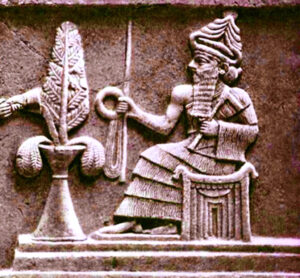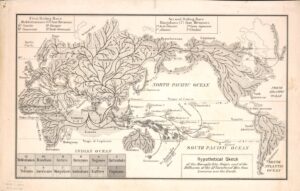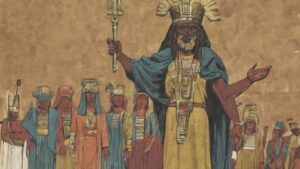Table of Contents
In ancient Mesopotamian mythology, Enlil, a prominent god in Sumerian and later Akkadian traditions, rules as the god of wind, air, earth, and storms. He holds a pivotal role in myths, tied to divine authority, kingship, and the fate of nations.
Origins
Various Mesopotamian myths depict Enlil’s birth and parentage differently. In one version, he is the son of An and Ki, representing the sky and earth. Another account involves his emergence from An and Nammu, a primeval goddess associated with waters. The specifics differ among traditions. Enlil resides in Ekur, the holy mountain considered the center of the earth and the gods’ dwelling place, where he presides over the divine council.
Appearance

Enlil was commonly portrayed in human form but with divine attributes and symbols, reflecting his divine status, authority, and connection with the heavens. Artistic representations varied across different periods and Mesopotamian art traditions.
Symbolism
In his association with the symbols of the hoe or pickax, Enlil signifies his role as a god of earth and agriculture. These tools symbolize his authority over land fertility. Additionally, artists sometimes depict Enlil with a horned crown, highlighting his divinity and leadership among the gods.
Family
Special Powers
In ancient Mesopotamia, people believed pleasing Enlil was crucial for agricultural prosperity. Considered a powerful deity associated with weather, particularly fertility-bringing rains, Enlil received appeasement through various rituals, prayers, and hymns to seek his favor for favorable weather conditions.
Farmers and priests honored and appeased Enlil by conducting ceremonies and making offerings, including food, drink, and symbolic items. The objective was to secure a bountiful harvest and safeguard against storms or droughts. As a weather god, Enlil held a central role in the well-being of the land and its inhabitants, motivating religious practices to foster a harmonious relationship. Temples devoted to Enlil served as places of worship, with priests facilitating communication between the people and the deity. Ancient Mesopotamians believed that pleasing Enlil was crucial for maintaining order in the natural world and ensuring agricultural success.
Modern culture:

Transitioning to the global presence of Mesopotamian artifacts, numerous museums house significant collections related to Enlil and the region’s archaeology. Notable among these institutions are:
Istanbul Archaeology Museums (Turkey). Comprising the Archaeological Museum, the Museum of the Ancient Orient, and the Museum of Islamic Art, they exhibit a diverse range of artifacts from the ancient Near East.
British Museum (United Kingdom). Located in London, it boasts an extensive collection encompassing objects tied to Sumerian, Akkadian, Babylonian, and Assyrian cultures.
Louvre Museum (France). Situated in Paris, the Louvre hosts a rich array of ancient Near Eastern artifacts, including sculptures and cuneiform tablets from Mesopotamia.
Iraq National Museum (Iraq). Based in Baghdad, it houses a significant collection despite facing looting and damage in the aftermath of the Iraq War.
University Museum, University of Pennsylvania (USA): The University of Pennsylvania Museum of Archaeology and Anthropology has a notable collection of artifacts from Ur in southern Mesopotamia.
Oriental Institute Museum, University of Chicago (USA): The Oriental Institute Museum houses a diverse collection of artifacts from the ancient Near East, including Mesopotamia.
These are just a few examples, and many other museums worldwide also feature Mesopotamian collections. Keep in mind that the availability of artifacts for public viewing may vary, and it’s advisable to check with the specific museum for the latest information on their exhibits and collections.
Who is Enlil in the Epic of Gilgamesh?
In the Epic of Gilgamesh, Enlil is one of the major gods mentioned. He plays a role in several parts of the epic, including the decision to send the flood.
What is Enlil the god of?
Enlil is often considered the god of wind, air, earth, and storms. He holds significant influence over natural forces and is associated with divine authority.
Who is Enki and Enlil?
Enki and Enlil are divine brothers in Mesopotamian mythology. Enki is associated with water, wisdom, and creation, while Enlil is linked to air, storms, and authority.
Why did Enlil order the flood?
In the Mesopotamian flood myth, Enlil orders the flood as a response to the noise and overpopulation of humans, finding their clamor disturbing. He aims to reduce their numbers.
What did Enlil look like?
Descriptions of Enlil's physical appearance vary across artistic representations, but he is generally depicted with divine attributes denoting his authority and celestial connection.
What does Enlil say to the council of the gods after hearing the clamor of mankind?
In the myth of the flood, Enlil addresses the divine council and justifies his decision to send the flood, emphasizing the disturbance caused by human noise and the need to control their overpopulation.




